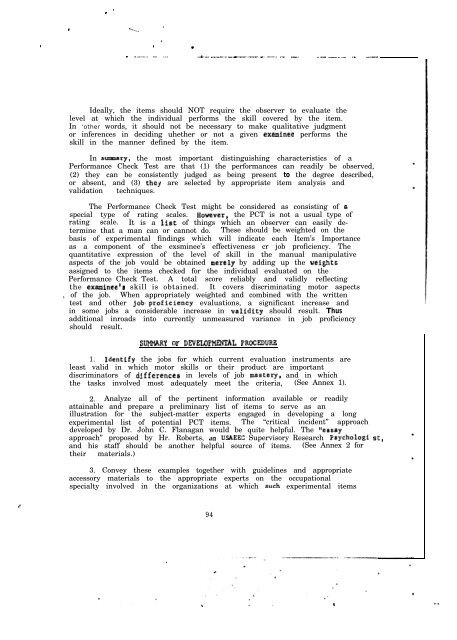Technical Report - International Military Testing Association
Technical Report - International Military Testing Association
Technical Report - International Military Testing Association
You also want an ePaper? Increase the reach of your titles
YUMPU automatically turns print PDFs into web optimized ePapers that Google loves.
,<br />
s<br />
.<br />
. ---_.<br />
. . .<br />
.<br />
.<br />
- -.--. .-. ._- .*__ ____-.._ -.-..-- -- --.. _.-<br />
“-. _-- ._-__.- .- ---<br />
Ideally, the items should NOT require the observer to evaluate the<br />
level at which the individual performs the skill covered by the item.<br />
In ‘other words, it should not be necessary to make qualitative judgment<br />
or inferences in deciding uhether or not a given exadntc performs the<br />
skill in the manner defined by the item.<br />
In btmary, the most important distinguishing characteristics of a<br />
Performance Check Test are that (1) the performances can readily be observed,<br />
(2) they can be consistently judged as being present to the degree described,<br />
or absent, and (3) they are selected by appropriate item analysis and<br />
validation techniques.<br />
The Performance Check Test might be considered as consisting of a<br />
special type of rating scales. Honever, the PCT is not a usual type of<br />
rating scale. It is a li.st of things which an observer can easily determine<br />
that a man can or cannot do. These should be weighted on the<br />
basis of experimental findings which will indicate each Item’s Importance<br />
as a component of the exsminee’s effectiveness cr job proficiency. The<br />
quantitative expression of the level of skill in the manual manipulative<br />
aspects of the job vould be obtained mensly by adding up the vei&tc<br />
assigned to the items checked for the individual evaluated on the<br />
Performance Check Test. A total score reliably and validly reflecting<br />
the exsminee’s skill is obtained. It covers discriminating motor aspects<br />
, of the job. When appropriately weighted and combined with the written<br />
test and other job,proficiency evaluations, a significant increase and<br />
in some jobs a considerable increase in validfty should result. Thus<br />
additional inroads into currently unmeasured variance in job proficiency<br />
should result.<br />
SlJHKARY OF DEVELOPMENTAL PROCEDURE<br />
1. ldenttfy the jobs for which current evaluation instruments are<br />
least valid in which motor skills or their product are important<br />
discriminators of d!.fferences in levels of job amstery, and in which<br />
the tasks involved most adequately meet the criteria, (See Annex 1).<br />
2. Analyze all of the pertinent information available or readily<br />
attainable and prepare a preliminary list of items to serve as an<br />
illustration for the subject-matter experts engaged in developing a long<br />
experimental list of potential PCT items. The “critical incident” approach<br />
developed by Dr. John C. Flanagan would be quite helpful. The “essay<br />
approach” proposed by Hr. Roberts, an USARES Supervisory Research Psychologi at,<br />
and his staff should be another helpful source of items. (See Annex 2 for<br />
their materials.)<br />
3. Convey these examples together with guidelines and appropriate<br />
accessory materials to the appropriate experts on the occupational<br />
specialty involved in the organizations at which such experimental items<br />
94<br />
.<br />
._









